Latest on COVID-19 in MN: Active cases climb; vaccination pace stays flat
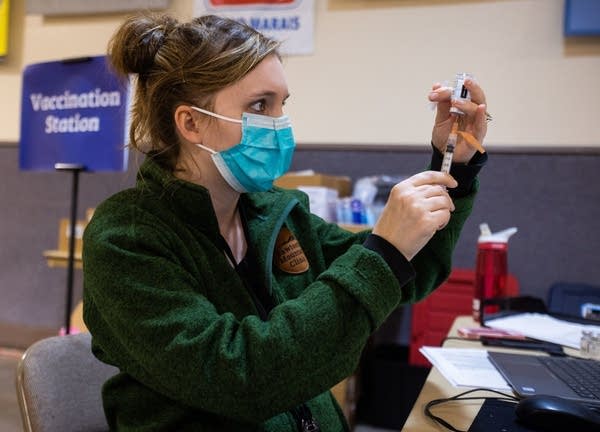
Go Deeper.
Create an account or log in to save stories.
Like this?
Thanks for liking this story! We have added it to a list of your favorite stories.
3 things to know
State set to open vaccine eligibility for all adults; supplies expected to jump in April
27.1 percent with at least one vaccine dose currently; 16.2 percent completely vaccinated
Active cases trending at levels not seen since late January
Updated 12:32 p.m.
The race is on to accelerate vaccinations against COVID-19 in Minnesota and dodge another surge in cases. Gov. Tim Walz is opening vaccine eligibility to any resident 16 and older starting Tuesday.
Friday’s Health Department data helps explain that rising urgency to widen the vaccine eligibility pool. The state remains stuck in a pattern where the vaccination pace has leveled off while active cases and hospitalizations edge higher.
Officials are increasingly anxious about caseloads tied to the U.K. COVID-19 variant and to youth sports. They’ve confirmed more than 500 cases of the U.K. strain in recent weeks and believe as many half the state’s new cases may be tied to that variant.
‘Vaccine nirvana’ near?
There’s no doubt the vaccination pace could use a bump.
Turn Up Your Support
MPR News helps you turn down the noise and build shared understanding. Turn up your support for this public resource and keep trusted journalism accessible to all.
The Health Department on Friday reported about 58,000 new vaccinations, keeping the seven-day trend running at around 40,000 shots daily, roughly what it’s been the past few weeks.
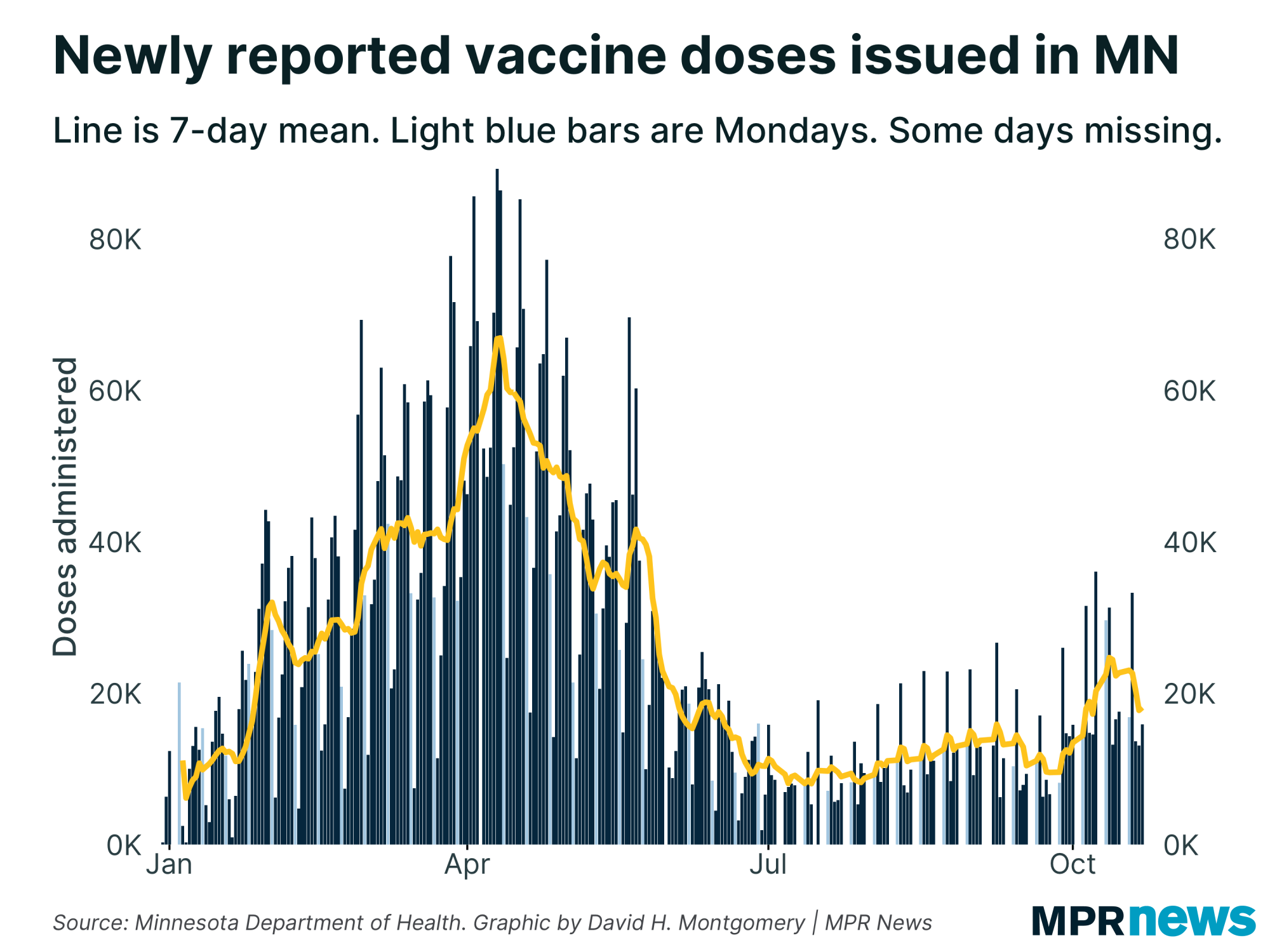
More than 903,000 people — about 16.2 percent of the state’s population — have completed their vaccinations while more than 1.5 million — 27.1 percent — have received at least one dose, including about 80 percent of people age 65 and older.
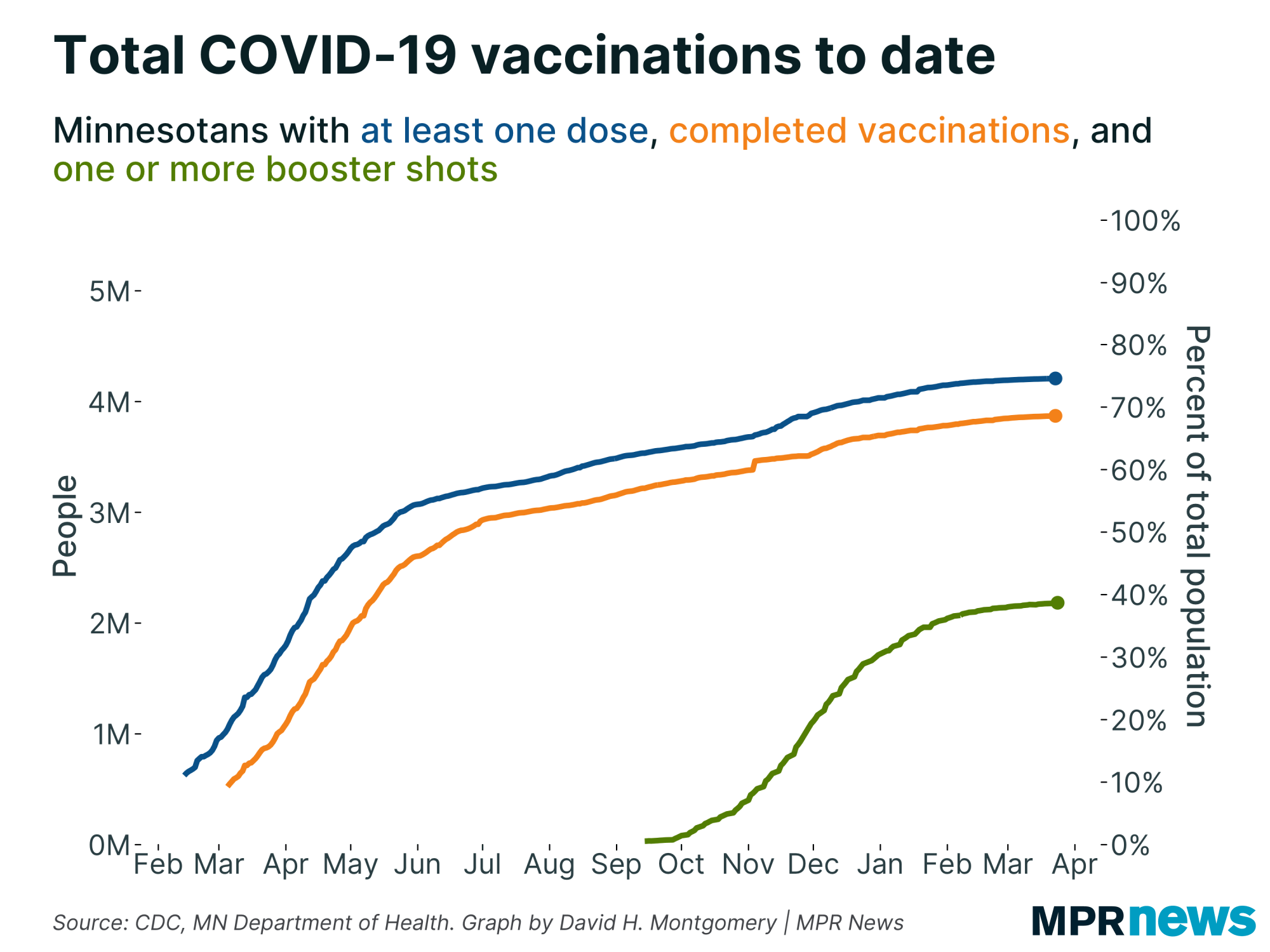
For those who’ve received a complete vaccination, the results look good so far. Of the more than 850,000 people completely vaccinated, the state’s identified only 89 who’ve subsequently tested positive for COVID-19.
Up to now, the shots have been targeted toward Minnesotans 65 and older, to those with certain underlying health conditions or who work in jobs that put them at highest risk of getting COVID-19.
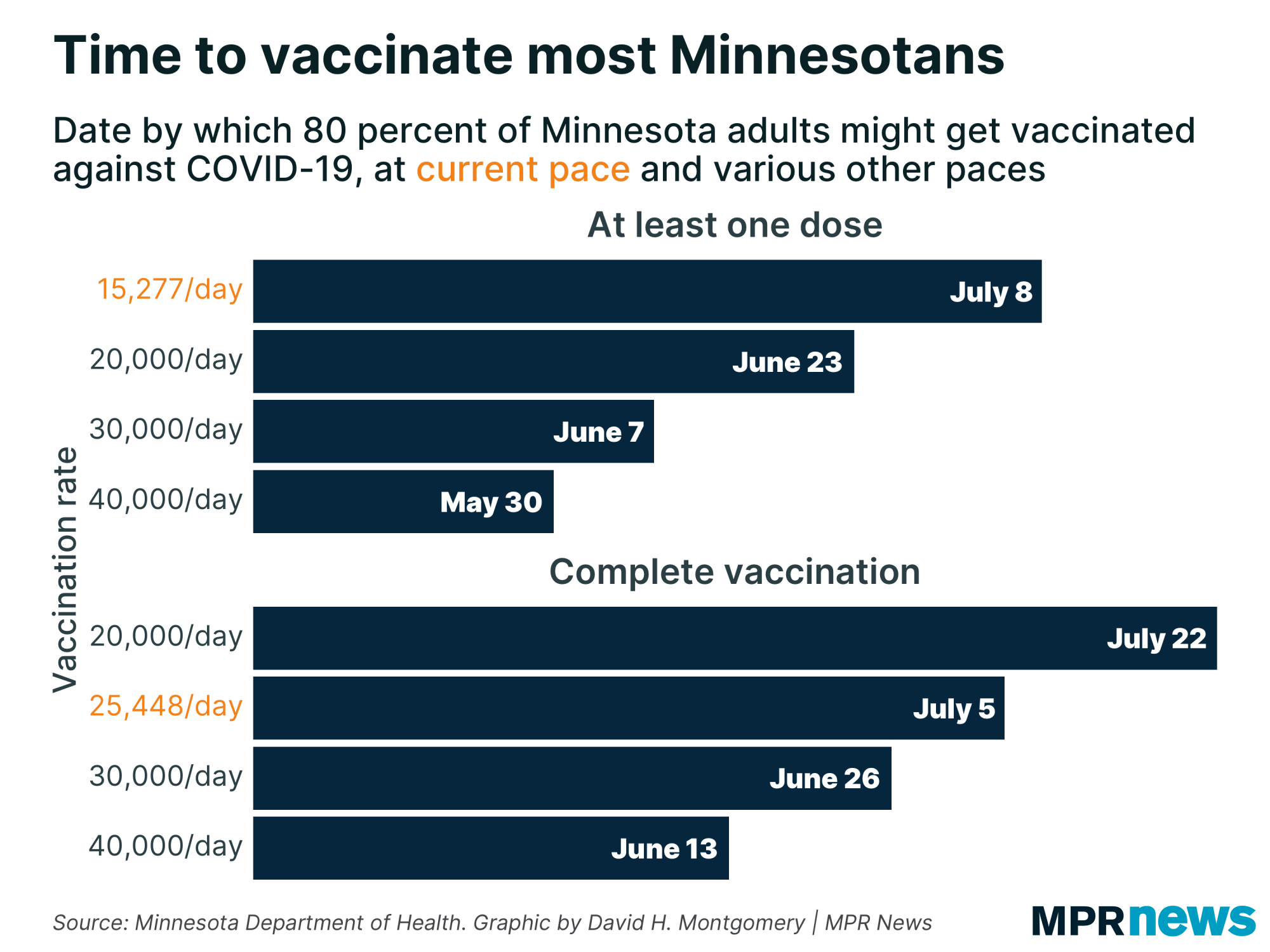
Health Department leaders, though, expect a major expansion of vaccine doses the first week in April — enough to give 300,000 Minnesotans their first shot and an additional 200,000 to provide people with a second shot.
That, together with the expanded eligibility, should go a long way to easing the concerns of a new wave, although officials noted the state won’t immediately have all the doses it needs to immediately vaccinate everyone who wants a shot.
“We have not achieved that vaccine nirvana … but we know it’s coming,” Kris Ehresmann, the state’s infectious disease director, told reporters.
Regional outbreaks concerning; active cases up
After a relatively stable stretch following a late fall surge, warning lights are flashing around Minnesota’s COVID-19 disease data.
The number of known, active is cases is rising again. Friday showed 12,604 active cases — marking eight consecutive days with active counts above 10,000, a stretch not seen since late January. It’s the first since mid-January that active cases have pushed above 12,000.
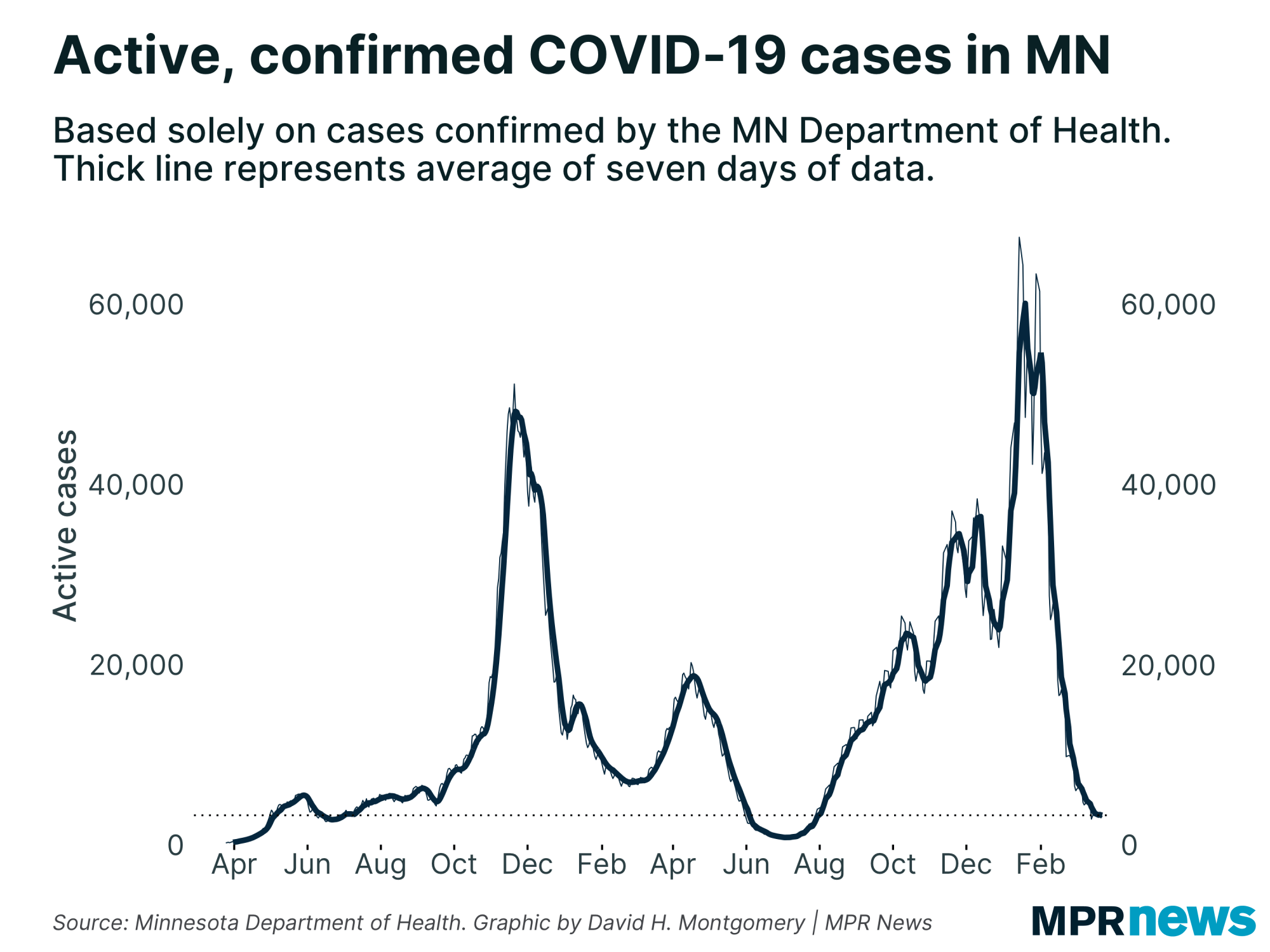
While still low compared to late November and early December, the increase is notable given the worries over the rise of the U.K. COVID-19 strain, which state health officials suspect is driving the current upswing.
Hospitalizations are low compared to the late-fall surge, but those counts are creeping up as well. Health Department data showed 357, people with COVID-19 in Minnesota hospitals; 87 needed intensive care.
Seven deaths reported on Friday raised Minnesota’s collective toll to 6,821. Among those who’ve died, about 63 percent had been living in long-term care or assisted living facilities; most had underlying health problems.
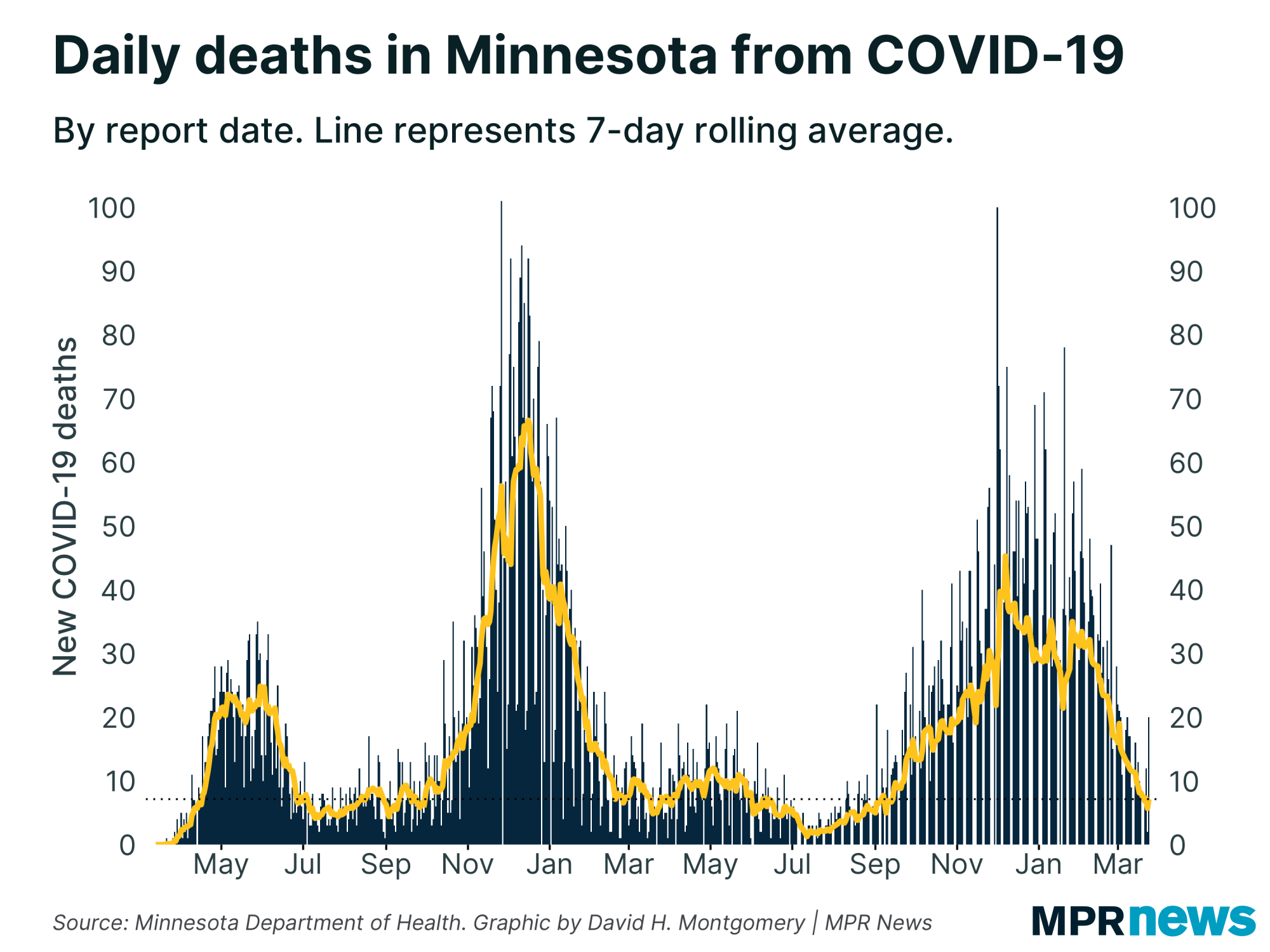
The state has recorded 512,097 total confirmed or probable cases so far in the pandemic, including 1,714 posted Friday. About 97 percent of Minnesotans known to be infected with COVID-19 in the pandemic have recovered to the point where they no longer need to be isolated.
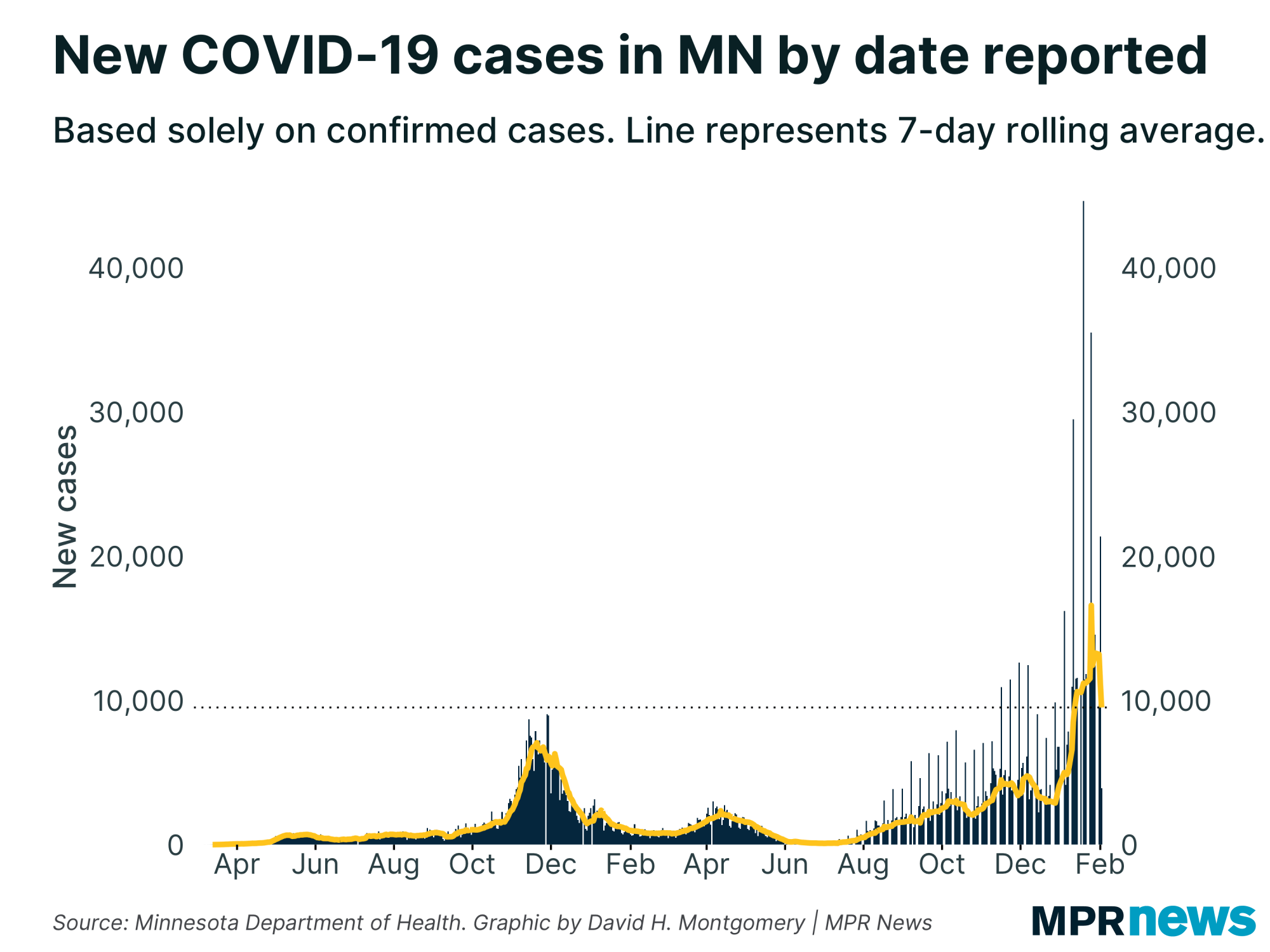
Regionally, all parts of Minnesota are in better shape than they were in late November and early December. Some areas are seeing upticks in cases.
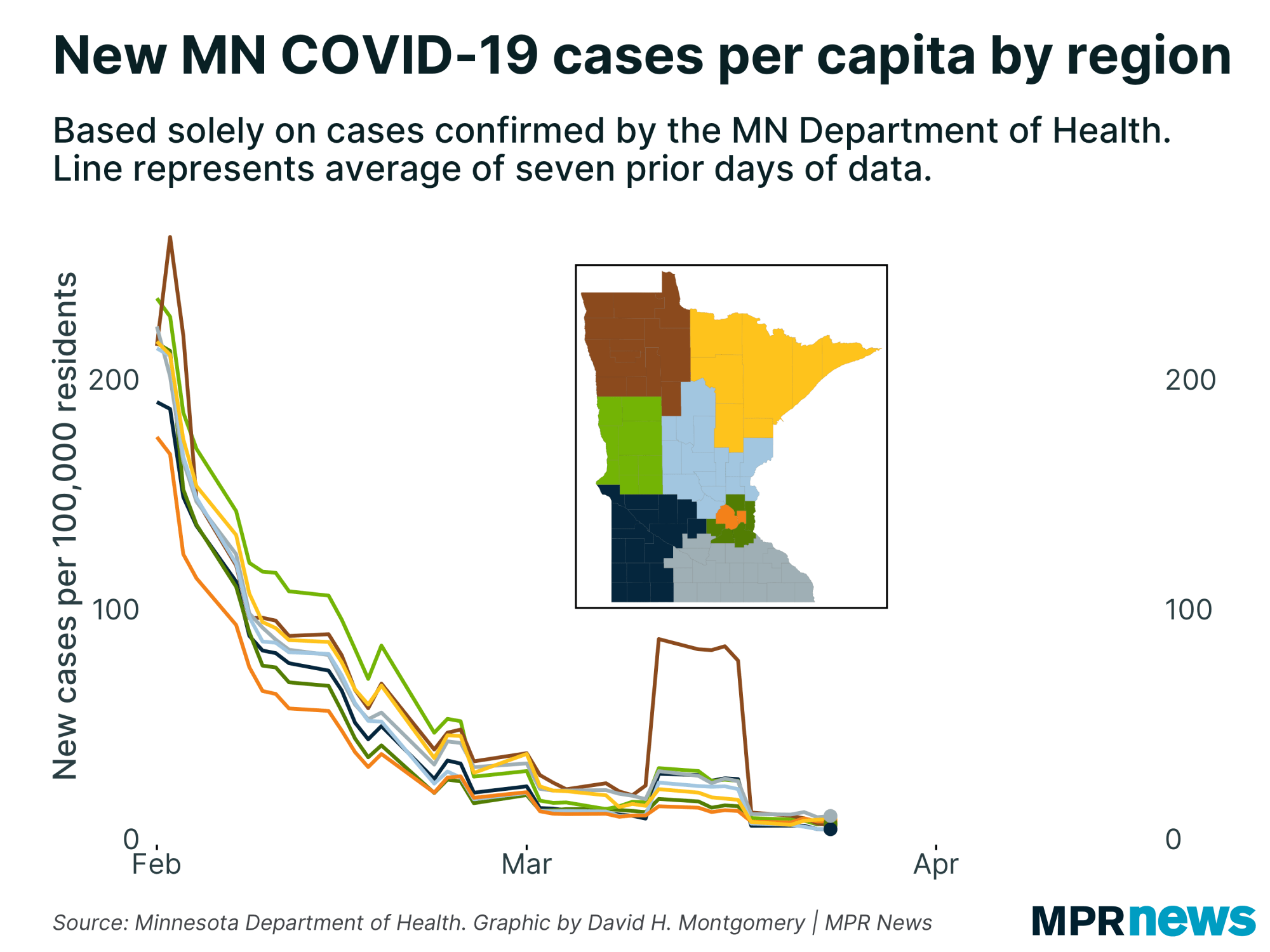
Public health leaders continue to keep watch on clusters in the southwest Twin Cities metro — specifically Carver and Scott counties — as well as the Mankato area and the eastern Iron Range, centered around the town of Aurora.
There’s also an outbreak now in Ely, northeast of Aurora. St. Louis County public officials say in the past week there have been 33 confirmed cases in Ely. That's about 15 percent of all COVID-19 cases in the entire county. Some of the cases are travel related. Others have been linked to social gatherings and youth sports activities.
Ely school officials report that about two-thirds of the cases in the city have been found in the schools, mostly in the high school. As a result, students are returning to distance learning for about two weeks in an effort to stop the spread.
The state is recommending young people across the state be tested every two weeks for COVID-19, with student athletes tested weekly.
Cases spread across age groups
People in their 20s still make up the age bracket with the state’s largest number of confirmed cases — more than 95,000 since the pandemic began, including more than 50,000 among those ages 20 to 24.
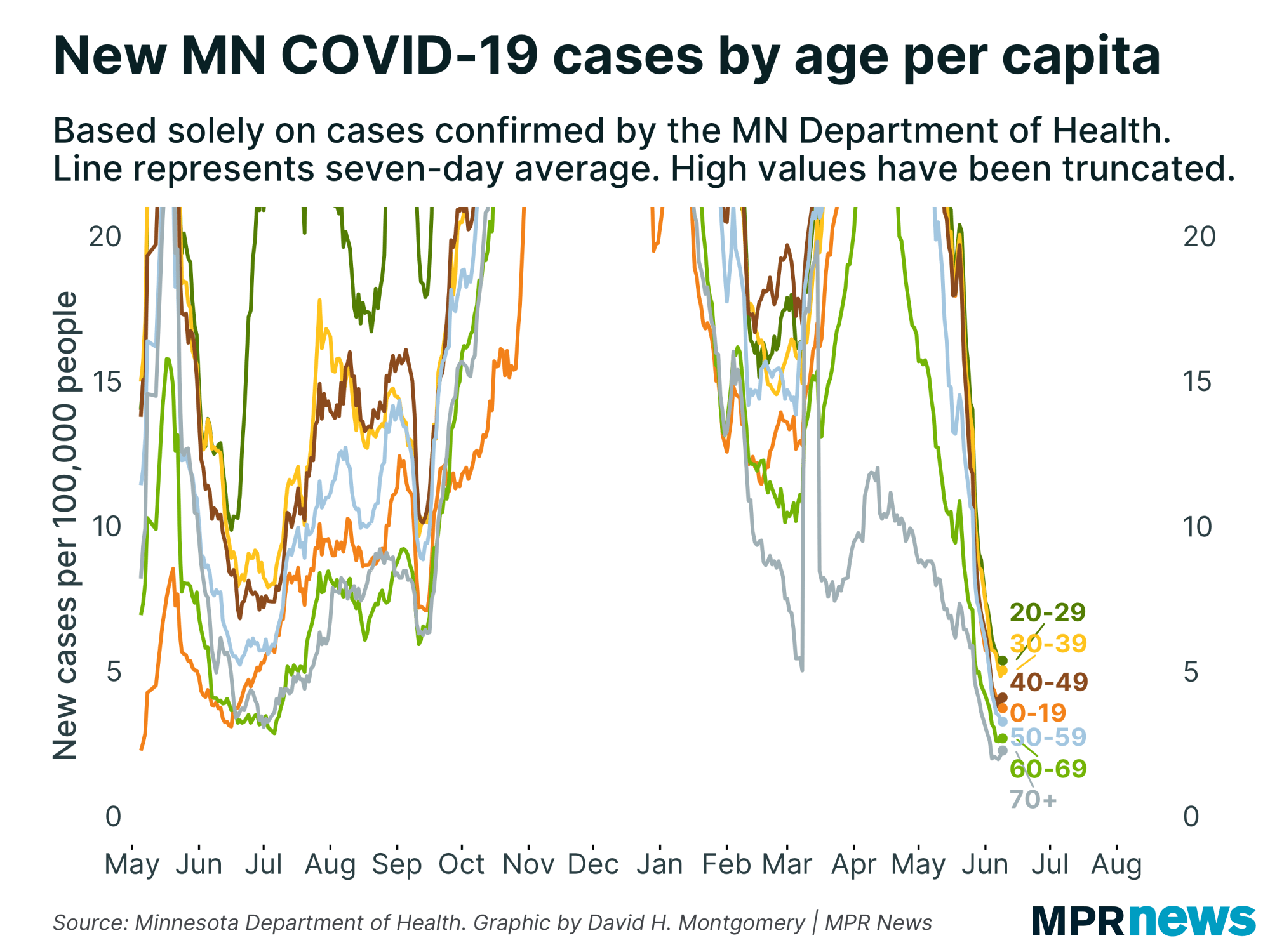
The number of high school-age youth confirmed with the disease has also grown, with more than 40,000 total cases among those ages 15 to 19 since the pandemic began.
With kids increasingly returning to school buildings and sports, Minnesota public health officials are urging Minnesota families with children to get tested every two weeks for COVID-19 now until the end of the school year.
Although young people are less likely to feel the worst effects of the disease and end up hospitalized, experts worry youth will spread it unknowingly to older relatives and members of other vulnerable populations. Those with the coronavirus can spread it when they don’t have symptoms.
Caseloads among people of color
In Minnesota and across the country, COVID-19 has hit communities of color disproportionately hard in both cases and deaths. That’s been especially true for Minnesotans of Hispanic descent for much of the pandemic.
Even as new case counts continue to track well below their late November, early December peaks, the data shows Latino people continue to be hit hard.
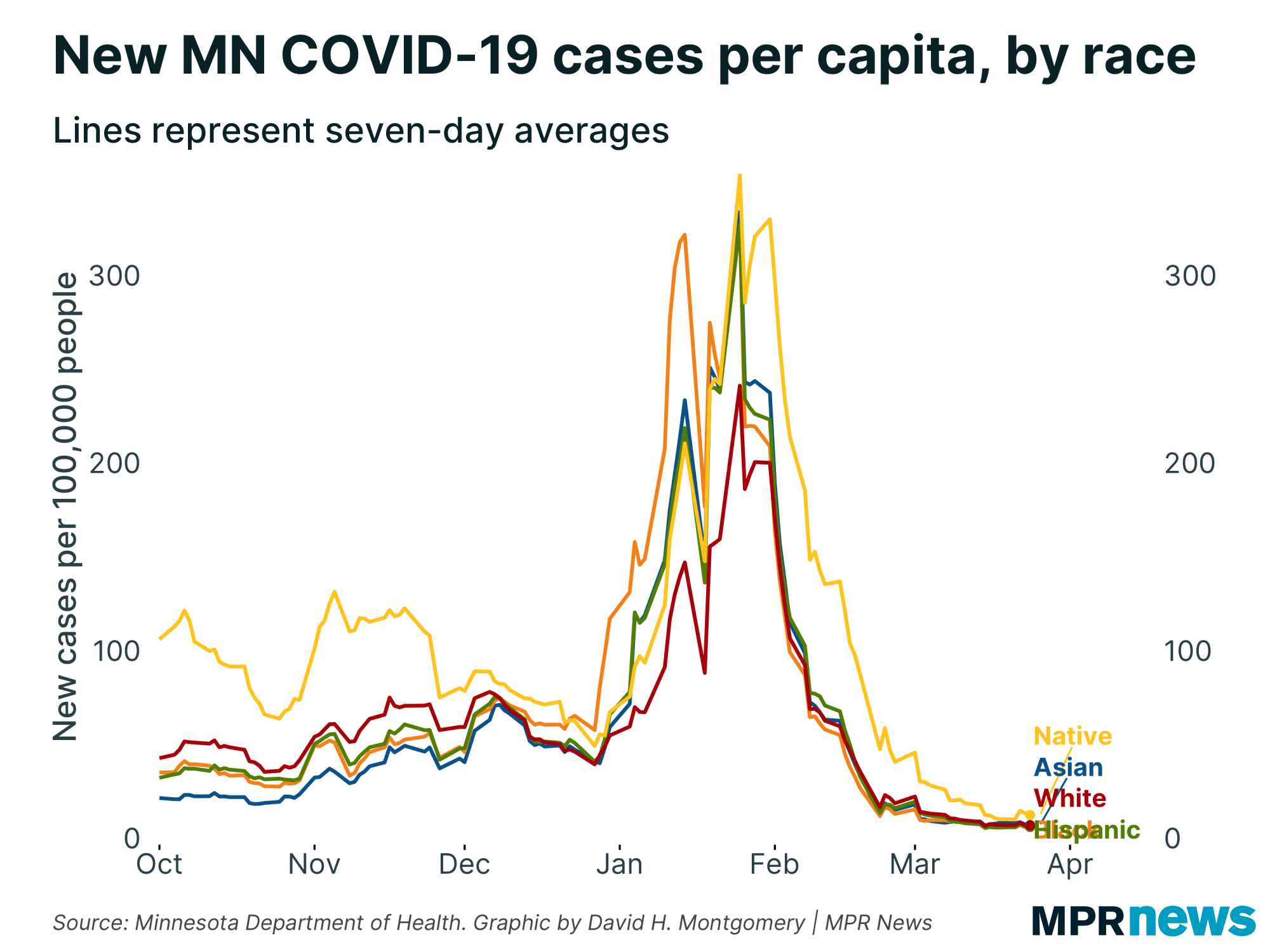
Distrust of the government, together with deeply rooted health and economic disparities, have hampered efforts to boost testing among communities of color, officials say, especially among unauthorized immigrants who fear their personal information may be used to deport them.
Walz has acknowledged that distrust by communities of color has been a problem during the pandemic. Officials have offered up some data on vaccinations broken down by race and ethnicity. The state is updating the data weekly.
Jan Malcolm, the state health commissioner, has said the state is committed to doing more to expand vaccine access to people of color, including getting more doses to community pharmacies, partnering with local groups and deploying mobile vaccination clinics.
Watch Gov. Walz and state health officials unveil plan to expand vaccine eligibility:
COVID-19 in Minnesota
Data in these graphs are based on the Minnesota Department of Health's cumulative totals released at 11 a.m. daily. You can find more detailed statistics on COVID-19 at the Health Department website.
Latest developments
COVID keeps Centennial High girls out of hockey tournament
A COVID-19 quarantine is forcing one team to miss the Minnesota High School Girls Hockey tournament.
The Centennial High School girls hockey team won't participate in this week's girl's hockey tournament because of a COVID-19 quarantine, according to the Minnesota State High School League.
The team reported it had a positive test.
Centennial, the section 5AA champion, was supposed to play Edina on Saturday. The league said it looked at options for a replacement team but could not make a plan work. Edina will advance to the next round of the tournament as a result.
— Peter Cox | MPR News
Twin Cities marathon is a go for October
Organizers say they're going ahead with the Twin Cities marathon events this fall, including the signature races between downtown Minneapolis and the Capitol. The races were canceled last year because of the pandemic.
The events will be smaller this year, with the marathon accepting only 4,000 entries. “Basically we're at half capacity,” said Virginia Brophy Achman, the marathon's executive director. “It's a number we can manage with the space allowed to comply with social distancing.
Marathon organizers will be urging spectators to stay away from the race course and will be restricting access in areas like the finish line, as a precaution against potential spread of COVID-19.
Registration opens on April 8.
— MPR News Staff
Top headlines
Minnesota to throw open COVID-19 vaccine eligibility: Beginning next week, Minnesotans 16 and older will be eligible for the COVID-19 vaccine. But eligibility, state leaders say, won’t guarantee an immediate shot, as officials work to inoculate the most vulnerable first.
Biden doubles goal of COVID vaccines to 200 million shots: President Joe Biden opened his first formal news conference Thursday with a nod toward the improving picture on battling the coronavirus, doubling his original goal by pledging that the nation will administer 200 million doses of COVID-19 vaccines by the end of his first 100 days in office.
Latina entrepreneurs find a space online to thrive in pandemic: Facebook Live boutique events provide needed income for entrepreneurs and create a virtual space for community members to come together in an isolated world. One Minnesota entrepreneur is among those finding success.


